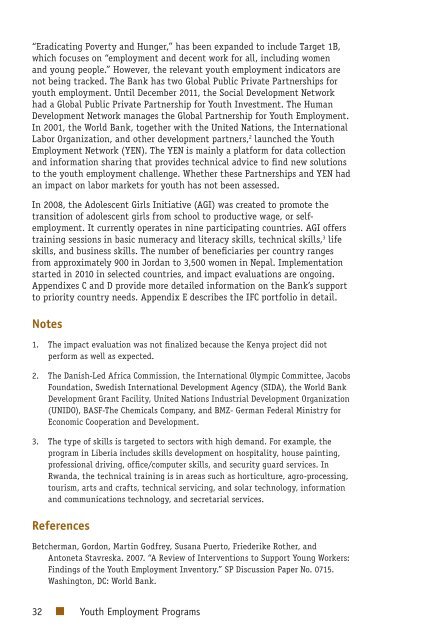Youth Employment Programs - Independent Evaluation Group
Youth Employment Programs - Independent Evaluation Group
Youth Employment Programs - Independent Evaluation Group
You also want an ePaper? Increase the reach of your titles
YUMPU automatically turns print PDFs into web optimized ePapers that Google loves.
“Eradicating Poverty and Hunger,” has been expanded to include Target 1B,which focuses on “employment and decent work for all, including womenand young people.” However, the relevant youth employment indicators arenot being tracked. The Bank has two Global Public Private Partnerships foryouth employment. Until December 2011, the Social Development Networkhad a Global Public Private Partnership for <strong>Youth</strong> Investment. The HumanDevelopment Network manages the Global Partnership for <strong>Youth</strong> <strong>Employment</strong>.In 2001, the World Bank, together with the United Nations, the InternationalLabor Organization, and other development partners, 2 launched the <strong>Youth</strong><strong>Employment</strong> Network (YEN). The YEN is mainly a platform for data collectionand information sharing that provides technical advice to find new solutionsto the youth employment challenge. Whether these Partnerships and YEN hadan impact on labor markets for youth has not been assessed.In 2008, the Adolescent Girls Initiative (AGI) was created to promote thetransition of adolescent girls from school to productive wage, or selfemployment.It currently operates in nine participating countries. AGI offerstraining sessions in basic numeracy and literacy skills, technical skills, 3 lifeskills, and business skills. The number of beneficiaries per country rangesfrom approximately 900 in Jordan to 3,500 women in Nepal. Implementationstarted in 2010 in selected countries, and impact evaluations are ongoing.Appendixes C and D provide more detailed information on the Bank’s supportto priority country needs. Appendix E describes the IFC portfolio in detail.Notes1. The impact evaluation was not finalized because the Kenya project did notperform as well as expected.2. The Danish-Led Africa Commission, the International Olympic Committee, JacobsFoundation, Swedish International Development Agency (SIDA), the World BankDevelopment Grant Facility, United Nations Industrial Development Organization(UNIDO), BASF-The Chemicals Company, and BMZ- German Federal Ministry forEconomic Cooperation and Development.3. The type of skills is targeted to sectors with high demand. For example, theprogram in Liberia includes skills development on hospitality, house painting,professional driving, office/computer skills, and security guard services. InRwanda, the technical training is in areas such as horticulture, agro-processing,tourism, arts and crafts, technical servicing, and solar technology, informationand communications technology, and secretarial services.ReferencesBetcherman, Gordon, Martin Godfrey, Susana Puerto, Friederike Rother, andAntoneta Stavreska. 2007. “A Review of Interventions to Support Young Workers:Findings of the <strong>Youth</strong> <strong>Employment</strong> Inventory.” SP Discussion Paper No. 0715.Washington, DC: World Bank.32 <strong>Youth</strong> <strong>Employment</strong> <strong>Programs</strong>
















